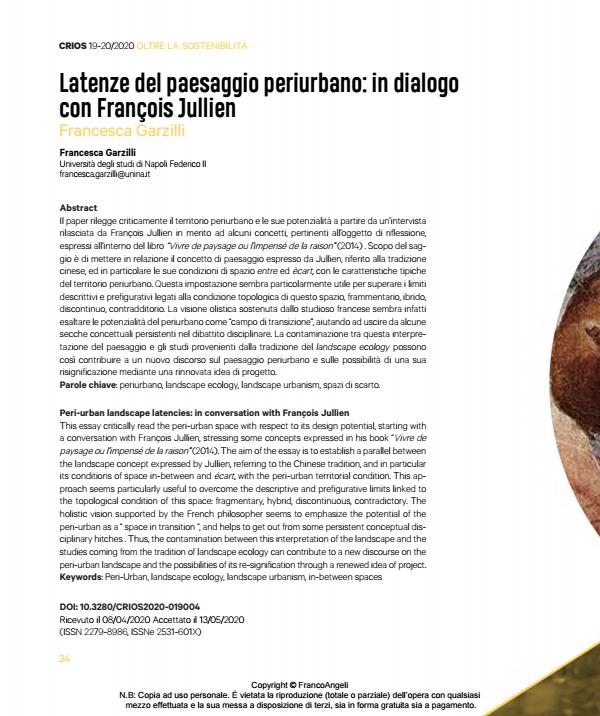Peri-urban landscape latencies: in conversation with François Jullien
Journal title CRIOS
Author/s Francesca Garzilli
Publishing Year 2021 Issue 2020/19-20 Language Italian
Pages 12 P. 34-45 File size 327 KB
DOI 10.3280/CRIOS2020-019004
DOI is like a bar code for intellectual property: to have more infomation
click here
Below, you can see the article first page
If you want to buy this article in PDF format, you can do it, following the instructions to buy download credits

FrancoAngeli is member of Publishers International Linking Association, Inc (PILA), a not-for-profit association which run the CrossRef service enabling links to and from online scholarly content.
This essay critically read the peri-urban space with respect to its design potential, starting with a conversation with François Jullien, stressing some concepts expressed in his book "Vivre de paysage ou l’impensé de la raison" (2014). The aim of the essay is to establish a parallel between the landscape concept expressed by Jullien, referring to the Chinese tradition, and in particular its conditions of space in-between and écart, with the peri-urban territorial condition. This ap¬proach seems particularly useful to overcome the descriptive and prefigurative limits linked to the topological condition of this space: fragmentary, hybrid, discontinuous, contradictory. The holistic vision supported by the French philosopher seems to emphasize the potential of the peri-urban as a - space in transition -, and helps to get out from some persistent conceptual dis¬ciplinary hitches . Thus, the contamination between this interpretation of the landscape and the studies coming from the tradition of landscape ecology can contribute to a new discourse on the peri-urban landscape and the possibilities of its re-signification through a renewed idea of project.
Keywords: Peri-Urban, landscape ecology, landscape urbanism, in-between spaces
- Amenta L., Attademo A. (2016). Circular Wastescapes. Waste as a resource for peri-urban landscapes planning. CRIOS, 12: 79-88.
- Attademo A., Formato E. (2019). Fringe Shift. Transforming Planning for new Suburban Habitats. Barcelona: List Lab.
- Berque A., Conan M., Donadieu P., Roger A. (2002). Mouvance: un lessico per il paesaggio. Il contributo francese. Lotus Navigator, 5 (Fare L’Ambiente).
- Clément G. (2004). Manifeste du Tiers paysage (ed.). Paris: Sujet.
- Corner J. (2014). The Landscape Imagination (1st editio; M. Baber, ed.). New York: Princeton Architectural Press.
- Donadieu P. (2013). Campagne urbane. Una nuova proposta di paesaggio della città. Roma: Donzelli editore.
- Dramstad W. E., Olson J. D., Forman R. T. T. (1996). Landscape Ecology Principles in Landscape Architecture and Land-Use Planning. Washington D.C.: Island Press.
- Fatigati L., Formato E. (2012). Campania Felix. Ricerche, Proposte, Nuovi Paesaggi 2002-2012. Roma: Aracne.
- Floch J.-M., Levy D. (2011). Le nouveau zonage en aires urbaines de 2010. Pourquite de la périurbanisation et croissante des grandes aires urbaines. Insee Première, (1375), 4.
- Forman R. T. T. (1995). Land Mosaics. The ecology of landscape and regions. Cambridge: Cambridge University Press.
- Forman R. T. T. (2008). Urban Regions. Ecology and Planning Beyond the City. New York: Cambridge University Press.
- Formato E., Amenta L., Attademo A. (2017). Wastescape e flussi di rifiuti: materiali innovativi del progetto urbanistico. Urbanistica Informazioni, 272: 956-963.
- Fors H., Busse A., Konijnendijk C. C., Bosch V. Den, Jansson M. (2018). From borders to ecotones – Private-public co-management of urban woodland edges bordering private housing. Urban Forestry & Urban Greening, 30 (November 2017), 46-55. -- https://doi.org/10.1016/j.ufug.2017.12.018.
- Geldermans B., Bellstedt C., Formato E., Varju V., Grunhut Z., Cerreta M., … Wandl A. (2017). REPAiR REsource Management in Peri-urban AReas: Going Beyond Urban Metabolism. (688920), 78.
- ICEPS (2019). L’economia circolare nelle aree urbane e periurbane. Rassegna Maggio 2019.
- Jullien F. (2014). Contro la comparazione. Lo «scarto» e il «tra» un altro accesso all’alterità. Milano: Mimesis.
- Jullien F. (2017). Vivere di paesaggio o l’impensato della ragione. Sesto San Giovanni: Mimesis.
- Khan A. (2016). Ecotone Thinking. Exploring the promise of landscape and design for the urbanising world. Scape, 15: 138-143.
- Koolhaas R. (1994). Delirious New York : a retroactive manifesto for Manhattan (New ed.). New York.
- Magnaghi A. (2010). Il progetto locale. Verso la coscienza di luogo. Torino: Bollati Boringhieri.
- Marot S. (2011). Sub-urbanisme/Sur-urbanisme. De Central Park à La Villette. 292-345.
- Mininni M. (2000). Il contributo dell’ecologia urbana per lo studio delle aree di margine. PROGETTAZIONE URBANA_Bollettino Dip. Prog. Urbana Federico II, 132-135.
- Mininni M. (2012). Approssimazioni alla città. Roma: Donzelli editore.
- Mininni M. (2013). Abitare il territorio e costruire paesaggi. Prefazione. In Campagne Urbane. Una nuova proposta di paesaggio della città (pp. XIII–LV). Roma: Donzelli editore.
- Mostafavi M., Doherty, G. (2010). Ecological Urbanism. Basel: Lars Müller.
- Nassauer J. I. (2012). Landscape as medium and method for synthesis in urban ecological design. Landscape and Urban Planning, 106(3), 221–229. -- https://doi.org/10.1016/j.landurbplan.2012.03.014
- Reed C., Lister N.-M., a cura di (2014). Projective Ecologies. Ney York: Actar Publishers.
- Russo M. (2014). Un’urbanistica per una diversa crescita? In Donzelli (Ed.), Urbanistica per una diversa crescita (pp. XV–XXX). Roma.
- Schön D. A. (1993). Il professionista riflessivo. Bari: Edizioni Dedalo.
- Secchi B. (1986). Il progetto di suolo. Casabella, 520, 19–23.
- Soja E. (2000). Postmetropolis: Critical Studies of Cities and Regions. Oxford: B. Blackwell ed.
- Steiner F., Weller R., Mcloskey K., Fleming B. a cura di (2020). Design with Nature Now. Lincoln Inst of Land Policy.
- Viganò P. ed. b. (2001). Territori della nuova modernità. Il Piano territoriale di Lecce. Napoli: Electa.
- Wandl A., Nadin V., Zonneveld W. A. M. (2014). Characteristics of territories-in-between. Landscape and Urban Planning, 130, 50-63.
- Weller R., Kjaersgaard S. P., Drozdz Z. (2019). Hotspot cities: Identifying peri-urban conflict zones. Journal of Landscape Architecture, 14(1).
Francesca Garzilli, Latenze del paesaggio periurbano: in dialogo con François Jullien in "CRIOS" 19-20/2020, pp 34-45, DOI: 10.3280/CRIOS2020-019004